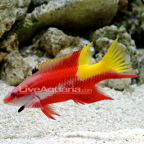
Additional locales and sizes may be available!
Additional locales and sizes may be available! Email me when availableQuick Stats
What do these Quick Stats mean? Click here for more information
What do these Quick Stats mean? Click here for more information
Overview
The female is yellow dorsally, and light blue ventrally. The caudal fin is marine-blue highlighted by a dark, blue-black edging on the top and bottom. The male is marked with a series of vertical red stripes covering the entire pale colored body. The tail of the male is forked and is yellow with blue edges.
A minimum of a 125 gallon tank or larger with lots of hiding places and live rock for grazing will offer an environment in which to thrive. An exception to most angelfish, the Blackspot Angelfish will make a good reef dweller, and will not nip at stony and soft corals (sessile invertebrates). It is also more peaceful and may be kept as a mated pair, or in schools. Fish of the genus Genicanthus are the only zooplanktivores among the angelfish.
The diet of the Spotbreast Angelfish should include Spirulina, marine algae, high-quality angelfish preparations, and finely shaved mysis or frozen shrimp.
Approximate Purchase Size: Small: 1" to 2"; Small/Medium: 2" to 3"; Medium: 3" to 4"; Medium/Large: 4" to 5"; Large: 5" to 6"; XLarge: 6" to 7"








